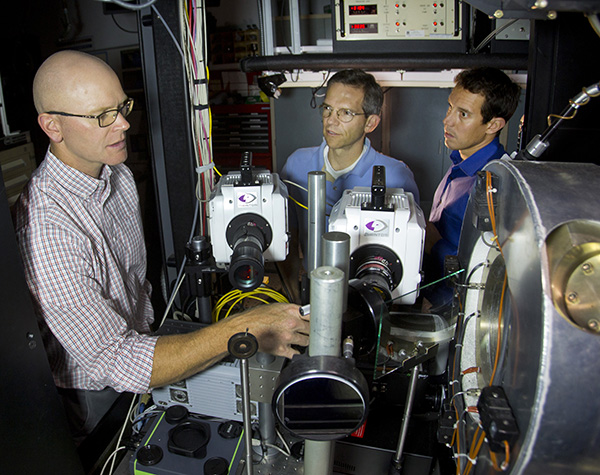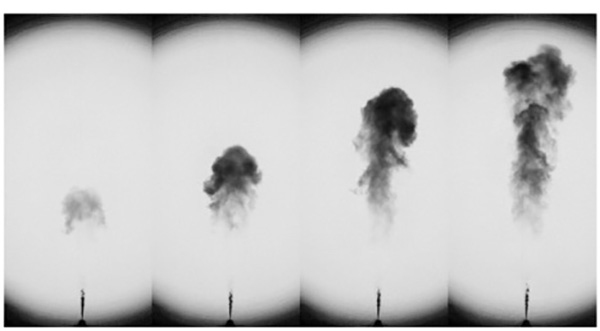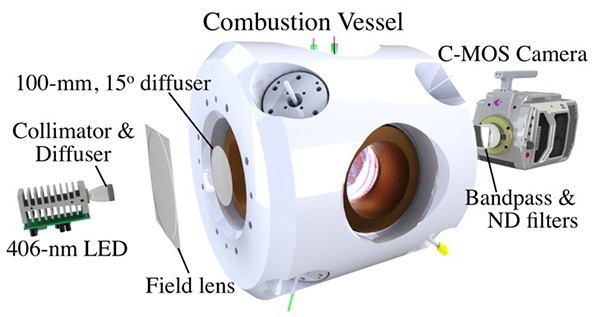New optical diagnostic helps improve fuel economy, reduce emissions

A new optical device at Sandia that helps researchers image pollutants in combusting fuel sprays might lead to clearer skies in the future.
An optical setup developed by researchers at Sandia’s Combustion Research Facility (CRF) and the Technical University of Denmark can now quantify the formation of soot — particulate matter consisting primarily of carbon — as a function of time and space for a variety of combustion processes. Initially, the researchers have focused on the combustion of liquid fuel sprays found in engines, where the extreme pressures and temperatures create an environment that is optically challenging.
To meet future particulate matter emissions mandates without sacrificing fuel savings, engine developers need advanced combustion strategies to reduce the formation of soot in spray flames.
“The acquired data provides important insights into the fuel spray motion as well as the timing and quantity of soot formed under a wide range of conditions,” says Sandia CRF researcher Scott Skeen. “Engine developers can use this information to validate computer models and design advanced engine combustion strategies that will improve fuel economy for consumers while also lowering tailpipe pollutant emissions.”
The work, published in an Applied Optics paper titled “Diffuse back-illumination setup for high temporally resolved extinction imaging,” was selected as a “Spotlight on Optics” by the Optical Society in July. Authors included Fredrik Westlye and Anders Ivarsson from the Technical University of Denmark and Sandia researchers Scott, Keith Penney, Lyle Pickett, and Julien Manin.

High-speed diagnostics will shed light on future research
The optical setup was developed to quantify soot formation in high-pressure, engine-relevant spray flames produced in Sandia’s optically accessible, constant volume, pre-burn, combustion chamber.
Imaging flames at temperatures and pressures found in engines can be difficult because of a phenomenon called “beam steering,” which occurs when light passes through a medium with varying refractive indexes. The phenomenon is commonly observed as a mirage on the highway in the summer time. The hot pavement heats up nearby air causing its refractive index to change. The sunlight changes direction as it passes from cooler air through hotter air, and these steered light rays give the impression that there is water in the road — a mirage. In a similar way, a flame causes beam steering because of adjacent high- and low-temperature regions. The magnitude of beam steering increases significantly in an engine because of the high pressures. With optimized lighting and imaging optics, however, the effects of beam steering can be eliminated.
The special lighting was enabled by a custom engineered diffuser large enough to fill the area of Sandia’s spray combustion chamber window (100 mm). The engineered diffuser was specifically designed to emit light rays with the same brightness over a specified angular range. In this way, a light ray that gets steered as it passes through the flame will be replaced by another ray having the same intensity.
The angle of the engineered diffuser is optimized based on the physical dimensions of the experimental facility, the magnitude of the anticipated beam steering, and the collection angle of the imaging system.
“In fact,” Julien says, “without such a specific optical arrangement, quantifying soot via light attenuation in high-pressure spray flames, where beam steering is more severe, would not be possible.”
Making cleaner engines
Scott explains that although new diesel vehicles are cleaner than ever before, some of the latest-generation gasoline engines emit as much particulate matter as older diesel engines. The increased particulate matter can be attributed to the adoption of a gasoline direct-injection fuel system, which results in improved fuel economy and therefore lower carbon dioxide emission per mile driven.
Gasoline direct injection involves spraying high-pressure liquid gasoline directly into the engine cylinder rather than mixing and vaporizing the fuel in the intake port outside the cylinder. This method reduces heat loss and allows for freer airflow. However, consumer savings at the pump come at the cost of higher particulate matter emissions. Unlike the much-maligned black smoke emitted from older diesel engines, soot emitted from gasoline direct injection engines is invisible to the naked eye because of the particles’ very small size.
The diagnostic presented in this paper allows researchers to quantify the formation of particulate matter in combusting sprays with unprecedented temporal and spatial resolution. Insights gained and data acquired from the use of this diagnostic will inform and guide researchers and automotive manufacturers toward designs that maximize fuel efficiency while minimizing harmful tailpipe emissions.
A standardized method
The work is a significant contribution to the Engine Combustion Network which was established in 2010 by Sandia researcher Lyle Pickett. The network promotes collaboration among engine researchers around the world. Although participation is voluntary and the network provides no financial support, more than 15 institutions have contributed experimental data.
“The network represents the power of a grass-roots movement,” says Lyle. “We have accomplished 20 years’ worth of research in one-fifth of the time.”
“We have accomplished 20 years’ worth of research in one-fifth of the time.”
One challenge of the wide-ranging collaborative effort within the network is the standardization of experimental diagnostics. “With so many researchers eager to participate, it is important to ensure that everyone contributes high-quality data acquired in a technically sound manner,” Lyle says.
The optical technique developed in this work relies on light attenuation or extinction to quantify the amount of soot in a flame. As light enters the combustion vessel, it will be absorbed or scattered by soot particles. Light that is absorbed and some light that is scattered will not reach the camera sensor. This reduction in measured light intensity — relative to a clear optical path — can be related to the amount of soot present. To make implementation of this diagnostic tool convenient for network participants, the associated publication provides detailed guidance on the necessary equipment and instruction for dimensioning the illumination source and collection optics. The use of a Sandia-developed LED light source, as opposed to a high-speed laser, means the cost and complexity are significantly lower.
“This work aims to establish a standardized experimental method of extinction imaging that will increase the reliability and reproducibility of experimental measurements submitted to the network,” says Westlye.
